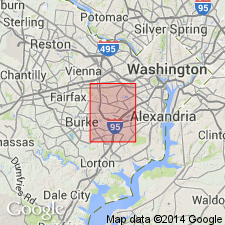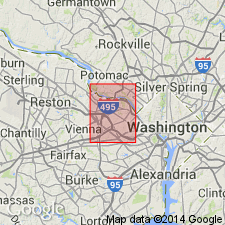
- Usage in publication:
-
- Popes Head Formation*
- Modifications:
-
- Named
- Dominant lithology:
-
- Phyllite
- AAPG geologic province:
-
- Piedmont-Blue Ridge province
Summary:
The Popes Head Formation, here named, is a sequence of metasiltstone and phyllite in northern VA that was originally named the Clifton Phyllite by Bennison and Milton (unpublished data, 1950). The unit is renamed the Popes Head Formation because the stratigraphic name Clifton is preempted. It contains the Old Mill Branch Metasiltstone Member and the Station Hills Phyllite Member. It overlies all other metasedimentary and transported meta-igneous rocks in northern VA and is intruded by the Occoquan Granite. Age is Late Proterozoic and (or) Early Cambrian.
Source: GNU records (USGS DDS-6; Reston GNULEX).

- Usage in publication:
-
- Popes Head Formation*
- Modifications:
-
- Age modified
- Geochronologic dating
Summary:
The age of the Popes Head Formation and its Old Mill Branch Metasiltstone and Station Hills Phyllite Members is now believed to be Cambrian because the Popes Head unconformably overlies the other lithotectonic units in the area, and is intruded by the Occoquan Granite, which may be as young as Late Cambrian, based on a Sr-Rb age of 494+/-14 Ma.
Source: GNU records (USGS DDS-6; Reston GNULEX).

- Usage in publication:
-
- Popes Head Formation
- Modifications:
-
- Overview
- AAPG geologic province:
-
- Piedmont-Blue Ridge province
Summary:
Popes Head Formation is divided on the State map into Station Hills Phyllite and Old Mill Branch Metasiltstone [Members]. Unconformably overlies the Mather Gorge, Sykesville, and Yorkshire Formations, the Annandale Group, and the Piney Branch Complex. Intruded by the Occoquan granite, which has been dated at 479+/-9 Ma by J.N. Aleinikoff (1993, written commun., U-Pb single-crystal zircon). Map symbol indicates that age of Popes Head is considered Cambrian and Ordovician.
Source: GNU records (USGS DDS-6; Reston GNULEX).

- Usage in publication:
-
- Popes Head Formation*
- Modifications:
-
- Overview
- AAPG geologic province:
-
- Piedmont-Blue Ridge province
Summary:
Popes Head Formation unconformably overlies Annandale-Indian Run motif [tectonic package] and Mather Gorge-Sykesville motif. Intruded by Occoquan Granite [dated at 560 Ma by Seiders and others (1975)] so it must be Cambrian or older; most likely Cambrian because it is not as complicated metamorphically or structurally as are the Late Proterozoic and (or) Early Cambrian motifs.
Source: GNU records (USGS DDS-6; Reston GNULEX).
For more information, please contact Nancy Stamm, Geologic Names Committee Secretary.
Asterisk (*) indicates published by U.S. Geological Survey authors.
"No current usage" (†) implies that a name has been abandoned or has fallen into disuse. Former usage and, if known, replacement name given in parentheses ( ).
Slash (/) indicates name conflicts with nomenclatural guidelines (CSN, 1933; ACSN, 1961, 1970; NACSN, 1983, 2005, 2021). May be explained within brackets ([ ]).

